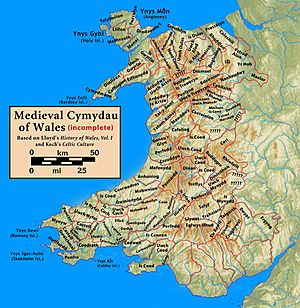Nanheudwy facts for kids
Nanheudwy was an important area in Wales during the Middle Ages. It was known as a "commote," which was a type of local district. Nanheudwy was part of the ancient Kingdom of Powys and located within a larger region called a "cantref" named Swydd y Waun. Its name might mean "Glens of the Dee," referring to the beautiful valleys of the River Dee.
Contents
What Was Nanheudwy?
Nanheudwy was a medieval Welsh "commote." A commote was a small, local area within a larger Welsh kingdom. It was like a mini-county with its own local rules and leaders. Nanheudwy was located between the valleys of two rivers, the Dee and the Ceiriog. A mountain ridge also ran through this area.
Where Was Nanheudwy Located?
This historic area was found in the northeastern part of Wales. It sat between the River Dee and the River Ceiriog. These rivers flow through deep valleys, and Nanheudwy included the land between them. A long mountain ridge also formed part of its landscape.
Nanheudwy Through Time
Nanheudwy's history changed a lot over the centuries. It was part of different kingdoms and administrative areas.
Part of Powys Fadog
From the year 1160, Nanheudwy was part of a larger Welsh kingdom called Powys Fadog. This was a Welsh "principality," which means it was ruled by a prince. Powys Fadog lasted until 1277.
Becoming a Marcher Lordship
When Powys Fadog ended in 1277, Nanheudwy became a "marcher lordship." A marcher lordship was a special area along the border between Wales and England. These areas had their own laws and were often ruled by powerful lords.
Joining Denbighshire
In 1542, Nanheudwy became part of a new "administrative county" called Denbighshire (historic). This change was part of a bigger plan to organize Wales like the "shires" (counties) in England. This meant it was now governed under English county laws.
Later County Changes
The area of Nanheudwy moved between different counties over time.
- In 1974, it was moved to a new county called Clwyd.
- Then, in 1996, it was returned to a newly organized Denbighshire.


